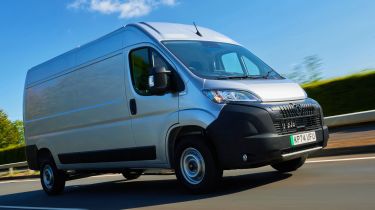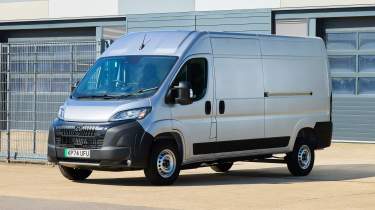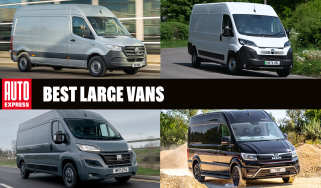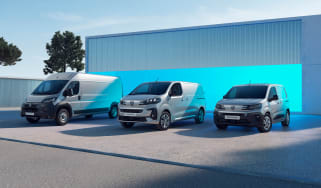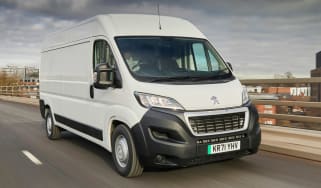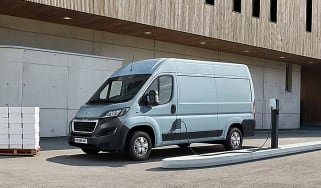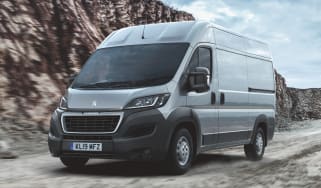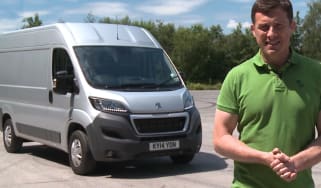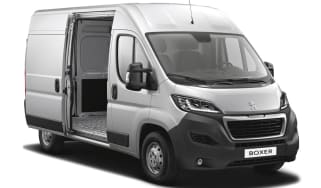Peugeot Boxer van review
The Peugeot Boxer’s wide array of body styles and vast cargo capacity mean it’s versatile, but the choppy ride limits its appeal
Our opinion on the Peugeot Boxer
The Peugeot Boxer is a popular large panel van that’s been on sale for many years through facelift after facelift. The latest one has added more tech but the fundamentals are still here: it has a range of punchy but noisy diesel engines, loads of cargo space and a wide array of body styles to choose from. There’s also an electric e-Boxer that delivers good range and more refined driving manners. Overall the Boxer is worth considering but rival vans are available that feel more up-to-date.
About the Peugeot Boxer
The Peugeot Boxer is a large van that shares a lot of parts with several other models including the Fiat Ducato, Citroen Relay, Vauxhall/Opel Movano and Toyota ProAce Max (plus the US-only Ram Promaster). These models are all from the Stellantis group and aside from slightly different equipment, are largely the same van in different clothes.
You’ll notice the new lights and grille but the Boxer isn’t all that different from before. Behind the cabin it’s all very familiar and the 2.2-litre BlueHDI 138bhp engine is still available, along with a 178bhp version of the same unit. Manual or automatic gearboxes are available and all versions are front-wheel drive.
The electric e-Boxer has a 110kWh battery and a 268bhp electric motor powering the front wheels, and of course being electric it’s auto-only. It’s a strong performer from low speed and is the best of the bunch to drive, while also delivering decent range (up to 261 miles according to official figures).
Used - available now

2022 BMW
3 Series Touring
53,301 milesAutomaticPetrol2.0L
Cash £19,159
2021 Ford
Mustang Mach-E
38,794 milesAutomaticElectric
Cash £18,403
2023 Audi
Q3
41,672 milesManualPetrol1.5L
Cash £24,719
2018 SEAT
Ibiza
40,631 milesManualPetrol1.0L
Cash £7,904The Boxer starts at around £31,500 (excluding VAT) for the panel van model in the smallest configuration of length and height. There are three lengths - L2, L3 and L4 - and three roof heights - H1, H2 and H3 - along with either light or heavy designations. The latter adds beefier suspension and some versions require either a pre-1997 licence or a C1 commercial vehicle licence to drive, so check you are legal before buying.
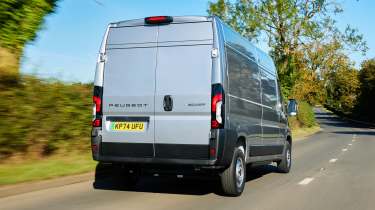
There are also Window Van models for carrying passengers, plus tipper and dropside versions. Peugeot offers fewer official conversions than some of its fellow Stellantis brands, there’s more choice with Fiat’s Ducato, for example. You can also only get the e-Boxer in L3H2, L3H3, L4H2 and L4H3 sizes and prices start at over £50,000 (before the plug-in vehicle grant).
There’s only one trim level, Professional, and standard kit includes air conditioning, rear parking sensors, cruise control, electric twin door mirrors, twin rear doors and a single nearside sliding door. A five-inch DAB radio screen with Bluetooth is standard on the diesel versions, and e-Boxer models come with a larger ten-inch screen with smartphone connectivity plus a seven-inch digital dash (replacing dials behind the wheel).
There are various option packs that let you add things like sat-nav, blind spot assist, wireless phone charging and keyless go. There’s also a worksite pack that adds mud and snow tyres and beefier suspension for use off-road.
MPG and running costs
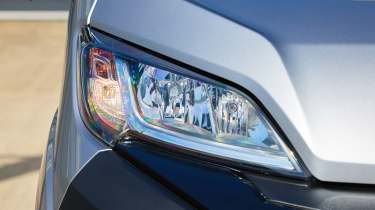
| Pros | Cons |
|
|
You can expect to pay around £31,500 for the entry-level manual 138bhp diesel, or add the automatic gearbox for around £2,000 extra. The 178bhp version comes in L4H2 form and costs from around £39,000, so won’t be a common pick - but the lower-powered version should be slightly more economical anyway, especially in lighter configurations.
Of course, fuel economy figures vary depending on which variant you pick, but you can expect around 38mpg at best and 30mpg at worst, according to Peugeot’s official WLTP test figures. It also depends on what kind of driving you do, as motorways will improve these figures and town driving will worsen them, likewise with light and heavy loads.
It costs about £800 to step up from the base L2H1 up to L2H2, L3H2 and L3H3 sizes, so budget a bit more if you need more roof height or load length. The electric e-Boxer starts from around £45,000 (with the government grant applied) and comes in L3H2, L3H3, L4H2 and L4H3 configurations only, again with around an £800 walk between them.
It’s a shame that certain options, like the spare wheel, are not included as standard - you’ll want to add a bit more budget to pick them as well. The hi-tech ten-inch screen (standard on EVs) is nice to have as well but it’s over £1,500 on the diesel models.
Electric range, battery life and charge time

According to official figures, you can drive the electric e-Boxer for up to 261 miles on a single charge. This depends entirely on many different factors, of course: if you drive at higher speeds, or with a heavy load, that figure will drop significantly.
The total capacity of the battery pack is 110kWh, of which 97.8kWh is usable. Charging is capped at 150kW, so you can pick up a five to 80 per cent charge in 55 minutes from a CCS rapid charge point. Normal 7.4kW single-phase charging (from a home or worksite wallbox) provides a full charge in around 17 hours, so unless you use most of the range every day, it should be doable overnight.
Load space and practicality

| Pros | Cons |
|
|
The Peugeot Boxer is a large panel van so it’s very spacious no matter which model you choose, but even the base model (L2H1) has a total of 10 cubic metres of space in the back. This figure goes up to 11.5 cubic metres in the higher-roofed L2H2, then 13 cubic metres in the longer L3H2. The figure increases again to 15 cubic metres in the L3H3 and L4H2 models, then to 17 cubic metres in the L4H3.
The Ford Transit, a benchmark van in this class, has a total of 15.1 cubic metres, so the Boxer beats that, but the Mercedes Sprinter matches the Peugeot’s 17 cubic metres. Other vans on this platform (the Citroen Relay, Fiat Ducato et al) have the exact same dimensions and cargo capacity as the Boxer.
The wheelbase of the Boxer comes in two forms: 3,450mm for the L2 model and 4,035mm for both the L3 and L4 lengths. This is because the longest model simply has more bodywork behind the rear axle rather than a longer wheelbase. The longest version is 6,363mm long in total, the L2 is 5,413mm and the L3 is 5,998mm.
The H1 model is 2,254mm high, while the H2 version increases that to 2,522mm and the H3 roof is 2,760mm. There is no difference in width between them: all are 2,050mm wide without the mirrors. The higher roofs are useful for loading up as you can easily stand up straight while inside, although all models have quite a high step to get in.
Some versions of the e-Boxer have a limited payload of under 700kg but there are heavy-duty models with up to 1,385kg maximum as well. Diesel models have payloads ranging from 1,235kg to just under two tonnes.
These models can tow from 2.25 to three tonnes and the electric model can pull up to 2,400kg. Tow hooks are available for £500 on the diesel model, but not on the e-Boxer, so you’ll need to go elsewhere to get one fitted on the electric version.
Reliability, safety and security
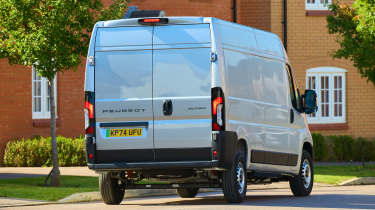
| Pros | Cons |
|
|
The latest Peugeot Boxer is up-to-date with the latest van safety standards, which means it comes with airbags for the driver and both passengers and autonomous emergency braking with pedestrian and cyclist detection. Traffic sign recognition and lane assist are included too, plus there’s a reversing camera which is really useful given how big the van is.
Euro NCAP gave the Boxer and its Stellantis stablemates a five-star overall rating with a 78 per cent score for safe driving, a 64 per cent score for tech, and an 80 per cent score for post-crash safety.
Deadlocks and an alarm are fitted as standard, which is good for security, but it’s a shame you have to pay extra for a spare wheel. It’s an item that could be the difference between a day’s lost work or a few minutes’ hassle, so is well worth adding.
The engines in the Boxer are well-known by now and are also shared between vans from Fiat, Vauxhall, Citroen and more. Even the electric e-Boxer has an identical motor and battery to the other electric vans in this group, so we’d expect no major issues from the powertrains. The electric versions have the least to go wrong, so they should be excellent in that regard.
The Boxer comes with a three-year or 100,000-mile warranty. There’s also an eight-year additional cover period for the battery in the electric model that covers it for a loss of capacity up to 70 per cent.
Driving and performance

| Pros | Cons |
|
|
Although it looks fairly modern from the front thanks to the facelift, the Peugeot Boxer has actually been on sale for quite a while and it feels it from behind the wheel. It’s more dated-feeling than rivals like the Ford Transit or Renault Master.
There’s a lot of wind and road noise in all versions, plus the diesel engines are rattly and noisy. The e-Boxer doesn’t suffer from the rattly engine issue and it’s rather pleasant at low speed to have such little noise, but it can’t escape the rush of air at high speeds that can be tiring.
The electric model is also more comfortable when unladen (since it has heavy batteries under the floor to weigh the suspension down). The diesel models are pretty bouncy and unpleasant if you don’t have anything in the cargo area, since the suspension is designed around having a lot of stuff pressing down on it.
The Boxer is a big van, so it’s not suited to small streets and city driving, and the A-pillars create some blind spots up front you’ll need to be aware of. The large twin door mirrors are useful for seeing what’s behind, though, and there’s a reversing camera as standard.
Both the 138bhp and 178bhp versions of the 2.2-litre diesel engine are punchy and give good performance, so should be up to carrying plenty of cargo. The manual gearbox isn’t the best, so we’d go for the automatic model if possible. It makes the driving experience feel a little less old-fashioned and smoother.
The best van in the range to drive is the e-Boxer by far, as it’s more comfortable and the electric motor is super smooth, quiet and very powerful. It’s more than capable when it comes to performance and when unladen you could even call it fast.
Town driving, visibility and parking

The Boxer is two metres wide and very long no matter which version you choose, so it won’t be suitable for a lot of city centre car parks and other tight streets. It’s something you may need to consider when picking a large panel van over a smaller model.
At least the Boxer comes with a reversing camera as standard, which will prevent some parking scrapes, and the electric model is nice and relaxed at low speed.
Motorway driving and long-distance comfort
The high level of wind and road noise at speed means all versions of the Boxer are pretty tiring to drive at speed for any length of time. Rivals such as the Renault Master feel a lot more modern in that regard. Unladen, the suspension tends to bounce and thud over bumpy sections and joints in the road surface, which make it all the more uncomfortable on the motorway.
Cab interior and technology
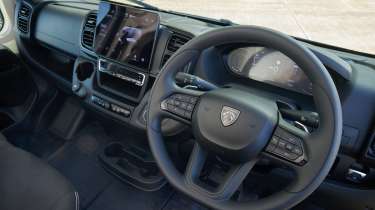
| Pros | Cons |
|
|
The cab of the Peugeot Boxer has been pushed right forward to make the cargo bay as big as possible, which means the driving position can feel a bit awkward. Taller drivers would be advised to test drive one before choosing it, as it might be a bit uncomfortable being so far forward. Shorter drivers might also have issues getting in, as it’s rather high up off the ground, but at least there are handles to help you pull yourself up.
There’s loads of headroom in the cabin, though, and since it’s so wide there is a lot of space for passengers in the two other two front seats. Unlike in smaller vans there won’t be an issue with it feeling cramped inside when three-up. A dual passenger seat is standard, with a single passenger seat as a no-cost option.
The Boxer cab includes plenty of stowage space, including two large glove boxes, one in the centre of the dashboard and the other in the usual place on the passenger side. The dash moulding includes a number of additional storage options on top of the dashboard plus there are large door bins, storage space under the seats and a shelf above the windscreen. High-roof variants actually have less space up top since that area is reserved for the actual cargo bay rather than as cabin space.
The plastics used in the cabin are cheap-looking but durable, while the touchscreen system works well while adding an air of modernity to the interior.
Infotainment, sat-nav and stereo

A five-inch DAB radio screen is standard on all models, and a seven-inch unit comes fitted to the electric e-Boxer. A ten-inch screen is available as an option and adds smartphone connectivity and sat-nav. This is a great system but it costs £1,500 as part of the tech pack, so might not be worth it for all buyers. Mounting your phone to the dash will do the job, so the screen is more of a nice-to-have than an essential feature.
Using Apple CarPlay or Android Auto on the screen is definitely the best set-up for navigation, though. Electric versions also come with a digital dash, replacing the dials behind the steering wheel, and these look suitably modern and work pretty well.
Buying and owning
Your main choice with the Boxer range will be whether you go for diesel or electric. The former will suit more buyers, since it has greater flexibility for long trips without stopping frequently. The e-Boxer electric van is surprisingly good for range, but when loaded up you might have to stop more often than you’d like, so we’d still say it’s best for shorter trips and driving in urban areas. You’ll then want to choose a length and height depending on your needs. Conversions including a tipper are available too.
Alternatives
Your other options here start with the other models based on the same parts as the Boxer: the Fiat Ducato, Vauxhall Movano, Citroen Relay and Toyota Proace Max. While there are spec differences, these are all pretty much the same thing with a different look. The Toyota has fewer variants but has a longer warranty than the others.
Looking elsewhere, you might think about a Volkswagen Crafter or MAN TGE, which are the same van under different badges, the Mercedes Sprinter or the Ford Transit. All of these are better to drive than the Boxer and feel more modern inside, although may not be as versatile.
Our current class favourite is the Renault Master, which is more refined and should have lower running costs than the Boxer too.
Peugeot Boxer pictures
Van dimensions
| |||
| Body style | Height | Width | Length |
| Boxer L2H1 | 2,254mm | 2,050mm | 5,413mm |
| Boxer L2H2 | 2,522mm | 2,050mm | 5,413mm |
| Boxer L3H2 | 2,522mm | 2,050mm | 5,998mm |
| Boxer L3H3 | 2,760mm | 2,050mm | 5,998mm |
| Boxer L4H2 | 2,522mm | 2,050mm | 6,363mm |
| Boxer L4H3 | 2,760mm | 2,050mm | 6,363mm |
Load area dimensions | ||||
| Body style | Height | Width | Length | Volume |
| Boxer L2H1 | 1,662mm | 1,870mm | 3,120mm | 10m3 |
| Boxer L2H2 | 1,932mm | 1,870mm | 3,120mm | 11.5m3 |
| Boxer L3H2 | 1,932mm | 1,870mm | 3,705mm | 13m3 |
| Boxer L3H3 | 2,172mm | 1,870mm | 3,705mm | 15m3 |
| Boxer L4H2 | 1,932mm | 1,870mm | 4,070mm | 15m3 |
| Boxer L4H3 | 2,172mm | 1,870mm | 4,070mm | 17m3 |
Frequently Asked Questions
There are many variants of the Peugeot Boxer, so there’s sure to be a size for you, but the van itself feels a bit dated. As long as the price is right, it’s not a bad van, but we reckon some of its rivals are better in many ways.

